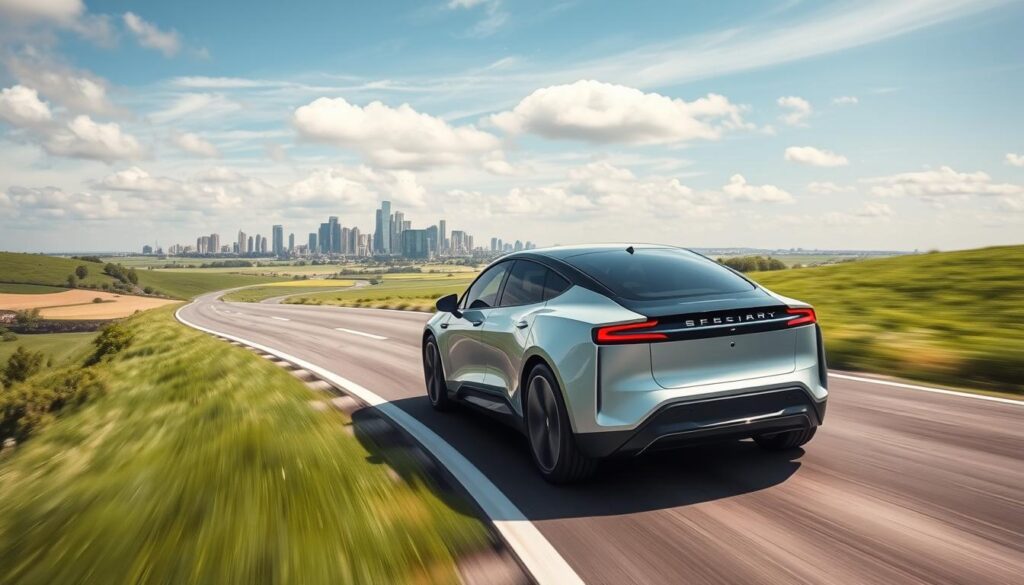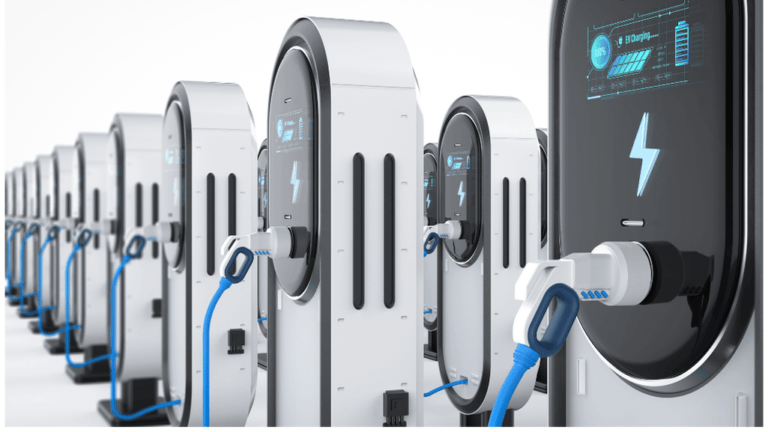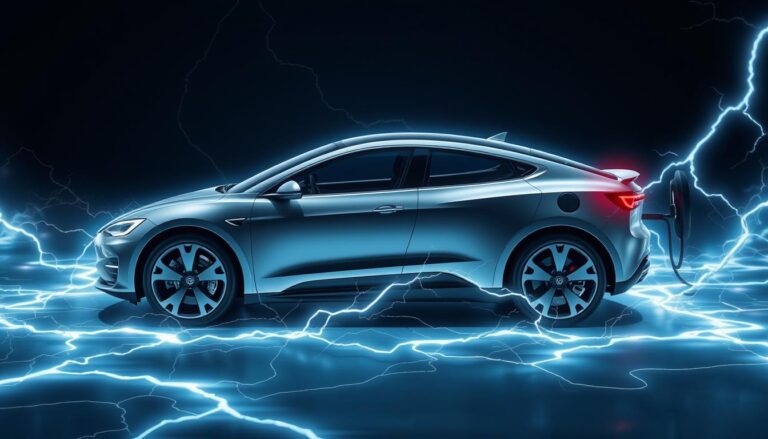The electric vehicle market trends show a big shift towards a greener future. China, Europe, and the United States are leading the way with their electric cars. China is at the forefront, selling the most electric vehicles even as incentives for buying them decrease.
In Europe, the adoption of electric vehicles is strong, despite fewer government incentives. The United States is also growing its electric vehicle market with policies like the Clean Vehicle Tax Credit. These regions are shaping the future of zero-emission vehicles.
Key Takeaways
- China’s dominance continues in the electric vehicle market trends, indicating market maturity.
- Europe’s electric vehicle registrations show resilience in the face of reducing subsidies.
- The EV industry analysis in the United States points to governmental incentives as growth catalysts.
- Market concentrations in these key regions are pivotal for global electric vehicle market trends.
- Policy and market conditions remain critical for understanding the trajectory of zero-emission vehicles.
- Adaptation and integration of clean vehicles are crucial for a sustainable automotive future.
Global Expansion and Regional Dominance in the EV Market
The electric car market is growing fast, with more sales and big policy support around the world. This shows how the EV market is getting bigger thanks to new tech and better policies.
Striking Sales Figures in China: A 35% Increase Despite Subsidy Cuts
China leads the world in electric vehicles, with a 35% jump in sales in 2023. Even with less government support, China’s market grew by focusing on high-end EVs and improving charging stations. This move shows how China’s electric car market is getting stronger.
Electric Vehicles in the United States: Growth and Policy Incentives
In the U.S., electric vehicle sales jumped by over 40%. This was helped by a better Clean Vehicle Tax Credit, one of many policy supports. These incentives make EVs more attractive to more people.
EU Electric Car Registrations: Milestones Achieved and Subsidy Impacts
Europe also saw a 20% rise in EV sales, showing a strong market and good response to policy support. But, sales dropped a bit in Germany towards the end, showing how complex market forces and policies affect EV adoption.
These regions tell a story of how EVs are becoming more popular worldwide. Policy incentives have helped speed up this growth. Subsidies have played a big part in shaping the EV market, showing how government support and market readiness work together.
Emerging EV Markets Showing Promising Growth Potential
The global electric vehicle (EV) market is growing fast, with new markets leading the way. Countries like India, Thailand, and Vietnam are seeing a big jump in EV sales. This shows a big move towards greener transport.
These countries are using government help and new industrial plans to push EVs. This move not only helps local car makers but also brings in green transport ideas into their economies.
What’s exciting is the many incentives that are making EVs more appealing. Things like lower taxes, cheaper registration fees, and direct cash help are making EVs more popular. This smart move could make these countries leaders in the EV world, right next to the big names.
| Country | Year-over-Year EV Growth | Key Incentives |
|---|---|---|
| India | 68% | Tax reductions, direct subsidies |
| Thailand | 45% | Registration cost reductions, EV grants |
| Vietnam | 56% | Green vehicle priority policies |
These new EV markets are not just growing fast in sales but also getting more popular with people and readying their infrastructure. This is key for making green transport a big success worldwide, changing the car industry for the better.
The entry of these markets into EVs is sparking new ideas and competition. It’s pushing the world towards more electric, efficient, and eco-friendly transport.
Financial Perspectives and Investor Confidence in EV Industry
The electric vehicle (EV) industry is growing fast, making investor confidence and EV stock market performance key to understanding its future. The electric vehicle market trends show strong growth but also ups and downs.
Recently, companies like Tesla and BYD have seen their values soar. But, the EV market can be unpredictable. Issues like supply chain problems and the cost of key battery materials make investors unsure. Past EV stock trends were up, but they don’t always predict what will happen next. This shows how speculative the EV market can be.
| Year | Market Size (USD Billion) | % Change |
|---|---|---|
| 2023 | 500.48 | Baseline |
| 2024 | 671.47 | +34% |
| 2032 | 1,891.08 | Estimated CAGR 13.8% |
Despite challenges, the electric vehicle market trends are strong. Investors are putting a lot of money into the sector. They’re focusing on making cars and the services and tech that go with them, like batteries and charging stations.
The US is planning big investments in EV charging stations. This shows a big commitment to the electric vehicle market. It helps improve EV stock market performance and sets the stage for more growth and tech progress.
The EV industry is all about fast tech changes and changing what people want. This means it’s growing fast but also changing a lot. Investors and experts need to be careful and understand the big benefits of electric vehicles.
In summary, the EV market has its ups and downs but is still very interesting to investors. Its ongoing growth and changes offer a promising future for those in the global electric vehicle market.
Supply Chain Challenges and Strategic Moves by Automakers
Automakers worldwide are forming strategic alliances to improve EV battery production. These partnerships help manage risks and increase production to meet the demand for electric vehicles.
These alliances focus on working closely with mining companies. They ensure a steady supply of key metals like lithium for EV batteries.
Stellantis and Volkswagen: Pioneering Supply Chain Partnerships
Stellantis and Volkswagen are leading the way with their strategic partnerships. They show how automakers can work together to overcome supply chain issues. These partnerships give them better access to resources needed for EV production.
The EV Battery Metal Race: Tesla and Korean Firms’ Strategic Plays in Chile
Tesla and Korean battery makers have teamed up with Chilean suppliers for lithium. This move helps reduce risks from supply chain volatility. It’s a key part of their strategy to improve EV battery production.
These partnerships mark a big change. Automakers are now actively involved in developing supplies and technologies. They use advanced analytics to predict demand accurately.
Working with tech providers and developing new materials is crucial. It helps reduce reliance on single suppliers. This makes the supply chain more resilient to disruptions.
Understanding these trends is key for the automotive industry. The strategies of companies like Stellantis, Volkswagen, Tesla, and Korean manufacturers will shape EV production and marketing in the future.
Electric Vehicle Market Trends: A Dive into Price Competitiveness and Market Share
The electric vehicle (EV) industry is growing fast. It’s seeing more sales and big changes in price competitiveness and market share. Companies like Tesla and BYD are leading the way, showing us what’s happening in the market.
Tesla and BYD’s Ongoing Battle for Market Supremacy
Tesla was a pioneer in electric vehicles and had a 13% market share in 2022. But, it has dropped from a peak of 17% in 2019. This drop is due to more competition and new players entering the market. BYD, on the other hand, is growing thanks to the big Chinese market and its efficient production methods. Both Tesla and BYD are trying to get more customers by changing their prices.
Price Wars: The Impact on EV Makers and Consumers
Big companies are fighting hard to be the cheapest, making EVs more affordable for everyone. This has led to a wider range of choices for buyers. Tesla offers high-end models, while BYD has more budget-friendly options. But, this competition is making it hard for companies to make a profit.
This fight for price is making other companies change their prices too. The electric vehicle industry analysis shows that new tech, government support, and eco-friendly choices are changing the game. These changes are making the industry more exciting and set for more growth.
As more people want EVs, the market is expected to grow from USD 396.4 billion in 2024 to USD 620.3 billion by 2030. Companies need to keep costs down and improve their technology. For example, Toyota is working on solid-state batteries that could go 1,000 km and charge in just 10 minutes.
These trends will affect everything from market shares to what customers choose. They will also change how companies plan their production and marketing. It’s a big shift that will impact the whole industry.
Sustainable Transportation Insights: Embracing Zero-Emission Vehicles
The growth of zero-emission technology is changing how we think about sustainable transportation. This change is thanks to smart EV adoption strategies and support from governments. It’s making a big difference for the environment around the world.
By 2020, electric vehicles (EVs) had grown a lot, reaching 10 million worldwide. This jump was led by battery electric vehicles (BEVs), which made up most of the new EVs sold.
In Europe, even though car sales dropped by 22%, EV sales doubled. This shows Europe is ready for a big change in what cars people want. Norway led the way with 75% of car sales being electric, setting a high standard for others.
Many things are pushing zero-emission vehicles forward. These include people wanting cleaner cars, laws to protect the environment, and big companies making their fleets greener. Big companies are leading the way by adding EVs to their fleets.
| Country/Region | Electric Car Stock (2020) | Market Share of EV Sales |
|---|---|---|
| China | 4.5 million | 5.7% |
| Europe | 3.2 million | 10% |
| United States | 295,000 | BEVs 78% |
| Canada | 51,000 | Unchanged from previous year |
| Norway | Data not specified | 75% |
| Japan | 29,000 | 0.6% |
Governments are helping by offering support and incentives for EV adoption strategies. Things like tax breaks, stricter rules on emissions, and orders from car companies are pushing the industry forward. These efforts aim to cut down on CO2 emissions a lot.
Together, policies, new technology, and a shift towards sustainability are making electric vehicles more popular. It’s clear that moving to sustainable transport is a big change. It’s not just a trend, but a key step towards a healthier future for everyone.
Automotive Giants’ Commitment to Electrification
Automakers’ EV strategies are changing fast. Big names like Ford, GM, and Volkswagen are making big moves towards electric cars. They’re planning to bring electric vehicles into the market on a big scale. With ambitious goals, these companies are leading the way in the electric vehicle market trends. They’re getting ready for a future where electric cars are the norm.
Recently, these companies have made big investments. Ford is putting $50 billion into electric vehicles by 2026. They aim to make 2 million EVs by then, showing a big step towards electric cars. Stellantis wants to sell only EVs in Europe by 2030, which is a clear move towards a greener future.
But, there are challenges. Companies like GM and Toyota are moving at different speeds towards electric cars. Yet, with more support from groups like the EPA, aiming to cut emissions by 2032, more companies might join the electric drive.
| Automaker | Investment by 2030 | 2030 EV Sales Target | Zero Emission Goal |
|---|---|---|---|
| Ford | $50 billion | 2 million units | 50% electric by 2030 |
| GM | Dynamic | Variable | Evolution towards ZEV |
| Stellantis | Aggressive | 100% in Europe | Net zero by 2038 |
| Volkswagen | $86 billion | Not specified | Significant EV lineup by 2040 |
Electrification in the car industry is more than just making EVs. It’s also about making cars more connected and sustainable. Forhad from EV Next Gen talks about how digital tech and sustainable cars will work together. This big change will affect how we use cars, including setting up charging stations and managing logistics.
As car companies change their plans and focus more on electric and digital cars, we can expect big changes in how we use car technology.
Implications of EV Growth on Traditional Vehicle Manufacturers
The move to electric vehicles (EVs) is changing the car industry a lot. Traditional car makers are now changing their plans to stay ahead. They’re learning about the EV penetration impact to keep up with the new trends.
Impact of EV Penetration on Incumbent Automakers
The rise of EVs is big news for traditional car companies. EV sales jumped from less than a million in 2016 to over 10 million in 2022. This change means car makers need to think differently about their products and plans.
Now, the International Energy Agency says EVs make up 14% of all cars sold, up from 4% in 2020. This shift is pushing car companies to focus more on sustainable and new car options.
Strategies of Legacy Brands in the Face of EV Disruption
To keep up with EVs, big car companies are improving their electric cars and using new tech. They’re putting money into making better batteries and electric engines. For example, they’re investing in new EV plants in the U.S. to stay competitive.
This change is big, affecting how cars are made and sold, and how companies talk to customers. How well traditional car makers adapt and innovate will decide their success in a world going electric.
Regional Analysis of EV Market Trends: A Focus on Policy and Industry
The electric vehicle (EV) market is changing fast, thanks to regional trends and policies. This look into the industry helps us understand what’s driving these changes.
In Europe and Asia-Pacific, we see these changes most clearly. Each region has its own policies and market responses that push the EV industry forward.
Europe’s Regulatory Framework Advancing EV Adoption
In Europe, tough rules and rewards have changed the EV market a lot. Tighter emission standards and perks for EV buyers have made Europe a leader in EV growth. Countries like Norway have seen a big rise in electric cars, thanks to strong government support.
Asia-Pacific’s EV Market: Expanding Beyond China
China leads the Asia-Pacific EV market, but countries like South Korea, Japan, and those in ASEAN are catching up. This change is thanks to new industry plans and local policies to cut oil use and emissions. Also, working with other countries and foreign investments have boosted tech and production, making the region’s EV scene more diverse.
Stats show EV sales and charging spots are on the rise, pointing to a strong future for the sector. ABI Research predicts more public charging points, making it easier for people to use EVs.
Supportive policies and growing industries are key to EV market trends. As countries keep innovating and focusing on EVs, the future of electric vehicles looks bright. This means a greener, more sustainable future for how we travel.
Conclusion
The electric vehicle market is moving fast towards a future where zero-emission cars lead. This change is driven by new tech, government support, and changing what people want. Big companies like Hertz, Tesla, and Rivian are facing ups and downs, but the market is growing and getting better.
Even with ups and downs, like Ford and General Motors making changes, the electric car market keeps moving forward. Government support and big investments from companies are helping a lot. Plus, new battery tech, like what Toyota is working on, is making people more excited about electric cars.
Electric cars are set to grow a lot, with a 5x increase to nearly 67 million units by 2035. This growth matches plans to ban cars that don’t run on electricity. For more info on what’s driving this change, check out Greenmatch’s detailed report on electric vehicles.










